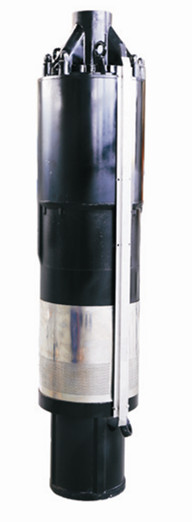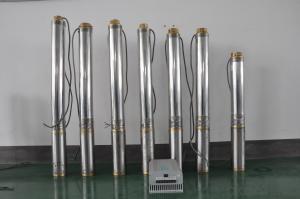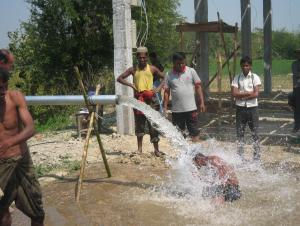Solar Water Pump 3DS-14
- Loading Port:
- China Main Port
- Payment Terms:
- TT OR LC
- Min Order Qty:
- -
- Supply Capability:
- 300 sets /month
OKorder Service Pledge
OKorder Financial Service
You Might Also Like
Product description:
Product: Solar water pump
Model:3DS-14

Appilication:
submersible pump
for deep well or pond or lake
for irrigation of a big farm with 12000 m2
Product specification:
flow rate:20m3/ hour, 160m3/day.
lift: 10m-50m
pump diameter: 296mm
well diameter more than 310mm
with BLDC motor, motor power:4000W
but only need solar power:2200W, our pump can save more than 50% solar panel power.
Material:
Pump inside: stainless steel and wearable nylon,it enables our solar pump to have 10 years sevice life.
Motor length:30cm,80% shorter than other motors. So that you can pump 80% more water by our solar pump.
Certification:
3 International patent
ISO9001
CE
Warranty:2 years
- Q:Can a solar pump be used for both water supply and irrigation?
- Indeed, a solar pump has the capability to cater to both water supply and irrigation needs. Its design enables it to extract water from sources like wells, rivers, or ponds, and subsequently pump it to the desired location. These applications can serve various purposes, including providing water for domestic use, livestock, and irrigation. Solar pumps prove to be particularly beneficial for irrigation, as they offer an eco-friendly and cost-effective solution. Their operation relies solely on abundant and renewable solar energy, reducing the dependence on electricity or fuel-powered pumps. This makes them especially suitable for areas that are remote or off-grid, where access to electricity may be unreliable or limited. Furthermore, solar pumps can be equipped with advanced features like timers and sensors, enabling automated irrigation systems. This ensures that crops receive the optimum amount of water at the appropriate time, promoting efficient water usage and maximizing crop yield. To sum up, solar pumps are highly versatile and can effectively fulfill both water supply and irrigation requirements. Their sustainable and environmentally friendly nature makes them a preferred choice for agricultural and water supply applications.
- Q:What is the impact of a solar pump on groundwater levels?
- A solar pump has a positive impact on groundwater levels as it utilizes solar energy to extract water from underground sources. This sustainable alternative to traditional pumps reduces reliance on fossil fuels and minimizes environmental impact. By efficiently extracting water, it helps maintain or replenish groundwater levels, contributing to the overall conservation and sustainability of water resources.
- Q:How does a solar pump handle water with high levels of organic matter?
- A solar pump can handle water with high levels of organic matter by using a filtration system. The pump typically includes filters that can remove larger particles and debris from the water, preventing clogging of the system. Additionally, some solar pumps may have advanced filtration mechanisms, such as activated carbon filters or UV sterilization, which can effectively eliminate organic matter, bacteria, and other contaminants in the water. This ensures that the pump is able to deliver clean and safe water, even when faced with high levels of organic matter.
- Q:How does the performance of a solar pump vary with different solar panel angles?
- The performance of a solar pump can vary with different solar panel angles. The optimal angle for the solar panels depends on the geographical location and the time of year. Generally, aligning the solar panels perpendicular to the sun's rays maximizes the energy conversion and thus enhances the pump's performance. However, if the angle is too steep or too shallow, the amount of sunlight reaching the panels decreases, resulting in lower energy production and reduced pump efficiency. Therefore, finding the ideal angle that captures the most sunlight throughout the day is crucial for optimizing the performance of a solar pump.
- Q:How long does it take to recharge the batteries in a solar pump system?
- The charging time for batteries in a solar pump system can differ based on various factors. These factors include the size and capacity of the batteries, the amount of available sunlight, and the efficiency of the solar panels. Typically, it takes several hours to fully recharge the batteries in a solar pump system. However, this duration can vary depending on the specific circumstances. For instance, if the solar panels receive direct sunlight throughout most of the day, the batteries may recharge more rapidly. Conversely, if the solar panels are partially shaded or if there is limited sunlight, the charging time may be extended. Moreover, the size and capacity of the batteries influence the charging time. Larger batteries with higher capacities will require more time to recharge compared to smaller ones. It is crucial to consider the battery size and capacity when designing the solar pump system to ensure that it can fulfill the required demand while allowing sufficient time for recharging. Lastly, the charging time is also affected by the efficiency of the solar panels. Solar panels with higher efficiency will convert more sunlight into electricity, resulting in faster battery charging. Therefore, investing in high-quality and efficient solar panels can help reduce the charging time of the batteries in a solar pump system. Overall, the charging time for batteries in a solar pump system can range from a few hours to an entire day, depending on the aforementioned factors. It is essential to consider these factors and design the system accordingly to ensure that the batteries have enough time to recharge and provide uninterrupted power for the pump.
- Q:Can a solar pump be used for emergency water supply?
- Yes, a solar pump can be used for emergency water supply. Solar pumps use solar energy to power the pumping mechanism, which means they do not rely on electricity or fuel, making them ideal for emergency situations where power may be limited or unavailable. They can be used to extract water from wells, rivers, or any other water source, providing a reliable and sustainable solution for emergency water supply needs.
- Q:Can a solar pump be used to create a water fountain?
- Yes, a solar pump can be used to create a water fountain. Solar pumps are designed to operate using solar energy, so they can be used to power a water fountain without the need for electricity. By connecting the solar pump to a fountain nozzle or other water feature, it can circulate water and create a visually appealing fountain display.
- Q:Can a solar pump be used for irrigation in sandy or arid areas?
- Yes, a solar pump can be used for irrigation in sandy or arid areas. Solar pumps are designed to operate using solar energy, which is abundant in such areas. They can effectively draw water from underground sources and distribute it for irrigation purposes, even in sandy or arid conditions. The use of solar pumps in these areas helps to reduce dependency on traditional energy sources and provides a sustainable solution for irrigation needs.
- Q:Can a solar pump operate at night or on cloudy days?
- Negative, a solar pump is incapable of functioning during nighttime or on cloudy days. The operation of solar pumps hinges upon the presence of sunlight as it generates the indispensable energy required for the pump's functioning. Absent sunlight, there exists no energy source to power the pump, rendering it incapable of operation during nighttime or on cloudy days when sunlight is inaccessible.
- Q:How does a solar pump handle water source contamination from sewage leaks?
- A solar pump does not have the capability to handle water source contamination from sewage leaks. It is primarily designed to extract and pump water from a source, but it does not possess any specific mechanisms to treat or purify contaminated water. In case of sewage leaks or water source contamination, it is essential to address the issue at its root cause and employ appropriate water treatment methods before using a solar pump or any other water extraction system.
1. Manufacturer Overview |
|
|---|---|
| Location | |
| Year Established | |
| Annual Output Value | |
| Main Markets | |
| Company Certifications | |
2. Manufacturer Certificates |
|
|---|---|
| a) Certification Name | |
| Range | |
| Reference | |
| Validity Period | |
3. Manufacturer Capability |
|
|---|---|
| a)Trade Capacity | |
| Nearest Port | |
| Export Percentage | |
| No.of Employees in Trade Department | |
| Language Spoken: | |
| b)Factory Information | |
| Factory Size: | |
| No. of Production Lines | |
| Contract Manufacturing | |
| Product Price Range | |
Send your message to us
Solar Water Pump 3DS-14
- Loading Port:
- China Main Port
- Payment Terms:
- TT OR LC
- Min Order Qty:
- -
- Supply Capability:
- 300 sets /month
OKorder Service Pledge
OKorder Financial Service
Similar products
New products
Hot products
Hot Searches
Related keywords


























